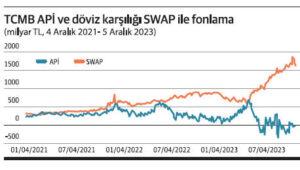
The chart shows the daily movements of the Central Bank’s open market operations (APİ) and FX swap transactions since the beginning of 2021. As shown in the chart, the days when the APİ has a positive value are the periods when the CBRT lends funds to banks. Notice that the APİ has been fluctuating around zero in recent months. Since the beginning of July, the APİ has averaged minus TRY 2.7 billion. In other words, for about 5.5 months, the Central Bank has been borrowing from banks instead of lending to them through the APİ, albeit in very small amounts.
So the first question is: What is the Central Bank’s policy rate in the second half of 2023? Since it does not lend to banks on average, the policy rate cannot be the weekly repo rate (providing TRY liquidity to banks against Treasury bond collateral at 40 percent interest), which is currently 40 percent. Since the Central Bank borrows from banks, the first thing that comes to mind is that the lower end of the interest rate corridor (the rate at which it borrows from banks) should be the policy rate (38.5 percent). Just as it was in the 2002-2009 period. But the amount the Central Bank borrows from banks is very low on average. Moreover, the Central Bank borrows for a few days and lends for a few days. In this case, it is difficult to take 38.5 percent as the policy rate.
The answer is hidden in the graph. The Central Bank has been providing significant amounts of TRY liquidity to banks mainly through swap transactions with maturities of up to three months. Especially in the period after the May elections, the amount of TRY provided through this channel skyrocketed. Since July, the swap has become almost the main TRY funding instrument. In this case, the swap rate should be the policy rate. What is its level? It is 4-5 points lower than the repo rate (i.e. 40 percent). Moreover, its maturity is three months, mostly. Now, if the bank borrows at this interest rate, even if the repo rate, which is supposed to be the policy rate, increases several times in three months, it is not affected by that increase.
There is another issue that is at least as important as the level of the policy rate. It is even more important. The Central Bank borrows from banks in foreign currency through the swap channel and lends them TRY in return. At maturity, the transaction is reversed. If it were an APİ transaction, it would lend TRY to banks against Treasury bonds. At maturity (one week later), the reverse process would take place and the banks would buy back their bonds and repay their TRY debt to the Central Bank. Caution: TRY-denominated treasury bonds are required as collateral against the TRY-denominated liquidity provided to banks through the normal channel, which is the APİ channel (of course, the Central Bank can ask for a different security, but this is mostly the practice). However, the TRY liquidity transferred to banks through swaps is in foreign currency. In a sense, this system encourages banks to borrow in foreign currency.
‘Dollarization’ instead of ‘liraization’… How does this benefit the Central Bank? It increases the gross foreign exchange reserve for the term of the swap. However, if the ‘return to rationality’ program represented a complete return to rationality, it would not only include interest rate hikes and tax increases to reduce the budget deficit. It would include these, but it would also include, for example, legal arrangements that would prevent Central Bank governors from being dismissed at will. Or institutional arrangements that will ensure confidence in the statistics announced will also be included in that program. Or, instead of the Central Bank working like an investment-development bank (for example, the investment commitment advance loans YTAK mechanism), investment-development banks will increase their functions. Given that the major central banks have reached the end of the interest rate hike process, such a program would increase the Central Bank’s foreign exchange reserves not artificially through swaps, but naturally, as the demand for TRY-denominated financial assets rises to the detriment of foreign currency-denominated ones. Moreover, not only gross reserves but also net reserves will increase.







